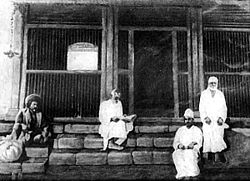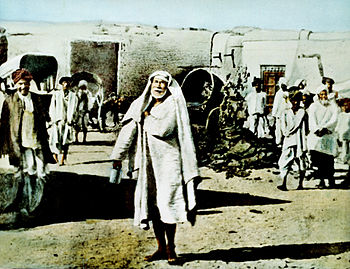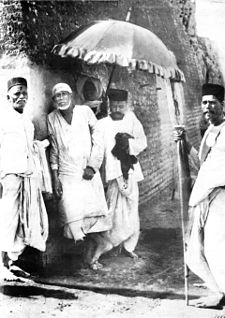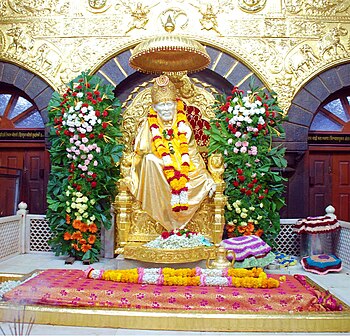Sai Baba of Shirdi
Jump to navigation
Jump to search
Sai Baba of Shirdi, also known as Shirdi Sai Baba, was an Indian spiritual master who is regarded by his devotees as a saint and a fakir. He is revered by both his Hindu and Muslim devotees during, as well as after his lifetime.
Sai Baba is now revered as an incarnation of Sri Dattatreya and considered as Saguna Brahma by his devotees. He is attributed to be the creator, sustainer and destroyer of this universe by his devotees. He is decorated with jewels and all forms of Hindu vedic deities as he is believed by his followers to be the supreme God.[2][3]
According to accounts from his life, he preached the importance of realization of the self and criticized love towards perishable things. His teachings concentrate on a moral code of love, forgiveness, helping others, charity, contentment, inner peace and devotion to the God and guru. He stressed the importance of surrender to the true Satguru, who, having trod the path to divine consciousness, will lead the disciple through the jungle of spiritual training.[4]
Sai Baba also condemned distinction based on religion or caste. It remains unclear if he was a Muslim or a Hindu. This, however, was of no consequence to Sai Baba.[5] His teachings combined elements of Hinduism and Islam: he gave the Hindu name Dwarakamayi to the mosque in which he lived,[6] practised both Hindu and Muslim rituals, taught using words and figures that drew from both traditions and took samadhi in Shirdi. One of his well-known epigrams, Allah Malik (God is King) and Sabka Malik Ek (Everyone's Master is One), is associated with both Hinduism and Islam. He is also known to have said Look to me, and I shall look to you[4] and Allah tera bhala karega.[7]
Sai Baba's real name remains unknown. The name Sai was given to him by Mhalsapati when he arrived at Shirdi, a town now in the west Indian state of Maharashtra. The word Sai refers to a religious mendicant[10] but can also mean God. In several Indian and Middle Eastern languages the term Baba is an honorific signifying grandfather, father, old man or sir. Thus Sai Baba denotes holy father, saintly father or (venerable) poor old man.[5]
Some of Sai Baba's disciples became famous as spiritual figures and saints, such as Mahalsapati, a priest of the Khandoba temple in Shirdi and Upasni Maharaj. He was revered by other saints as well, such as Saint Bidkar Maharaj, Saint Gagangiri Maharaj, Saint Janakidas Maharaj and Sati Godavari Mataji.[11][12] Sai Baba referred to several saints as 'my brothers', especially the disciples of Swami Samartha of Akkalkot.[12]
Sai Baba
| |
|---|---|

Photograph of Sai Baba of Shirdi
| |
| Died | 15 October 1918[1] Shirdi, Bombay Presidency, British India (present-day Maharashtra, India) |
| Resting place | Samadhi Mandir, Shirdi |
Quotation
1. Allah – Malik (God is Master)
2. Shraddha – Saburi (Faith – Patience)
3. Sabka Malik Ek (Everyone's master is one)
3. Sabka Malik Ek (Everyone's master is one)
Sai Baba is now revered as an incarnation of Sri Dattatreya and considered as Saguna Brahma by his devotees. He is attributed to be the creator, sustainer and destroyer of this universe by his devotees. He is decorated with jewels and all forms of Hindu vedic deities as he is believed by his followers to be the supreme God.[2][3]
According to accounts from his life, he preached the importance of realization of the self and criticized love towards perishable things. His teachings concentrate on a moral code of love, forgiveness, helping others, charity, contentment, inner peace and devotion to the God and guru. He stressed the importance of surrender to the true Satguru, who, having trod the path to divine consciousness, will lead the disciple through the jungle of spiritual training.[4]
Sai Baba also condemned distinction based on religion or caste. It remains unclear if he was a Muslim or a Hindu. This, however, was of no consequence to Sai Baba.[5] His teachings combined elements of Hinduism and Islam: he gave the Hindu name Dwarakamayi to the mosque in which he lived,[6] practised both Hindu and Muslim rituals, taught using words and figures that drew from both traditions and took samadhi in Shirdi. One of his well-known epigrams, Allah Malik (God is King) and Sabka Malik Ek (Everyone's Master is One), is associated with both Hinduism and Islam. He is also known to have said Look to me, and I shall look to you[4] and Allah tera bhala karega.[7]
Contents
Background
Sai Baba's date of birth including his birthplace remains unknown and is debatable due to lack of evidence and no definitive information exists to prove it. Most definitive information about Shirdi Sai Baba tends to be derived from a book called Shri Sai Satcharitra written by a disciple called Hemadpant (also known as Annasaheb Dabholkar / Govind Raghunath) in 1922 in Marathi.[8] The book itself is a compilation based on accounts by his various disciples and Hemadpant's personal observations observing Sai Baba from 1910 onwards.[9]Sai Baba's real name remains unknown. The name Sai was given to him by Mhalsapati when he arrived at Shirdi, a town now in the west Indian state of Maharashtra. The word Sai refers to a religious mendicant[10] but can also mean God. In several Indian and Middle Eastern languages the term Baba is an honorific signifying grandfather, father, old man or sir. Thus Sai Baba denotes holy father, saintly father or (venerable) poor old man.[5]
Some of Sai Baba's disciples became famous as spiritual figures and saints, such as Mahalsapati, a priest of the Khandoba temple in Shirdi and Upasni Maharaj. He was revered by other saints as well, such as Saint Bidkar Maharaj, Saint Gagangiri Maharaj, Saint Janakidas Maharaj and Sati Godavari Mataji.[11][12] Sai Baba referred to several saints as 'my brothers', especially the disciples of Swami Samartha of Akkalkot.[12]
Early years
Sai Baba (right) and some of his devotees at Dwarakamai, his own temple.
Sai Baba with some devotees
Baba reportedly arrived at the village of Shirdi in the Ahmednagar District of Maharashtra, India, when he was about sixteen years old. Although there is no agreement among biographers about the date of this event, it is generally accepted that Baba stayed in Shirdi for three years, disappeared for a year and returned permanently around 1858, just after the Indian Rebellion of 1857. This which posits a possible birth year of 1838.[17] He led an ascetic life, sitting motionless under a neem tree and meditating while sitting in an asana. The Sai Satcharita recounts the reaction of the villagers
The people of the village were wonder-struck to see such a young lad practicing hard penance, not minding heat or cold. By day he associated with no one, by night he was afraid of nobody.[18]His presence attracted the curiosity of the villagers and the religiously-inclined such as Mhalsapati, Appa Jogle and Kashinatha regularly visited him, while others such as the village children considered him mad and threw stones at him.[19] After some time he left the village and it is unknown where he stayed at that time or what happened to him. However, there are some indications that he met with many saints and fakirs and worked as a weaver; he claimed to have fought with the army of Rani Lakshmibai of Jhansi during the Indian Rebellion of 1857.[20]
Return to Shirdi
Sai Baba in his usual attire
Around this time he adopted his famous style of dressing, consisting of a knee-length one-piece Kafni robe and a cloth cap. Ramgir Bua, a devotee, testified that Sai Baba was dressed like an athlete and sported 'long hair flowing down to the end of his spine' when he arrived in Shirdi, and that he never had his head shaved. It was only after Baba forfeited a wrestling match with one Mohiddin Tamboli that he took up the kafni and cloth cap, articles of typical Sufi clothing.[21] This attire contributed to Baba's identification as a Muslim fakir and was a reason for initial indifference and hostility against him in a predominantly Hindu village.[22]
For four to five years, Baba lived under a neem tree and often wandered for long periods in the jungle around Shirdi. His manner was said to be withdrawn and uncommunicative as he undertook long periods of meditation.[23] He was eventually persuaded to take up residence in an old and dilapidated mosque and lived a solitary life there, surviving by begging for alms and receiving itinerant Hindu or Muslim visitors. In the mosque, he maintained a sacred fire which is referred to as a dhuni, from which he gave sacred ash ('Udi') to his guests before they left. The ash was believed to have healing and apotropaic powers. He performed the function of a local hakim and treated the sick by application of ashes. Sai Baba also delivered spiritual teachings to his visitors, recommending the reading of the Ramayan and Bhagavat Gita for Hindus and Qur'an for Muslims. He insisted on the indispensability of the unbroken remembrance of God's name (dhikr, and often expressed himself in a cryptic manner with the use of parables, symbols and allegories).[24]
Baba is believed to have grown and cultivated a garden called Lendi Baug, named after a riverlet called Lendi which flowed nearby.[25] The garden continues to be a place visited by pilgrims, and has temples, samadhis of people and animals associated with Shirdi Sai Baba's life and temples.[26]
In 1910, Sai Baba's fame began to spread in Mumbai.[27][28] Numerous people started visiting him, because they regarded him as a saint with the power of performing miracles or even as an avatar.[29] They built his first temple at Bhivpuri, Karjat.[30]
Final years and death (Samadhi)
In August 1918, Shirdi Sai Baba told some of his devotees that he would soon be "leaving his mortal body" (dying).[31] Towards the end of September, he had high fever and stopped eating.[32] As his condition deteriorated, he asked his disciples to recite holy texts to him and continued to meet visitors. On 15 October 1918, he breathed his last. The day coincided with the Hindu calendar date that year for Vijayadashami.[33][34] His remains were interred at "Buti Wada" in Shirdi, after which it became a place of worship known today as Shree Samadhi Mandir or Shirdi Sai Baba Temple.Teachings and practices
Shirdi Sai Baba, leaning against the wall of his masjid, with devotees
Sai Baba encouraged his devotees to pray, chant God's name, and read holy scriptures. He told Muslims to study the Qur'an and Hindus to study texts such as the Ramayana, Bhagavad Gita and Yoga Vasistha.[36] He was impressed by the philosophy of the Bhagavad Gita and encouraged people to follow it in their own lives.[37] He advised his devotees and followers to lead a moral life, help others, love every living being without any discrimination, and develop two important features of character: faith (Shraddha) and patience (Saburi). He criticised atheism.[38]
In his teachings, Sai Baba emphasised the importance of performing one's duties without attachment to earthly matters and of being content regardless of the situation. In his personal practice, Sai Baba observed worship procedures belonging to Islam; he shunned any kind of regular rituals but allowed the practice of Salah, chanting of Al-Fatiha, and Qur'an readings at Muslim festival times.[39] Occasionally reciting the Al-Fatiha, Baba enjoyed listening to mawlid and qawwali accompanied with the tabla and sarangi twice daily.[40]
Sai Baba interpreted the religious texts of both Islam and Hinduism. He explained the meaning of the Hindu scriptures in the spirit of Advaita Vedanta. His philosophy also had numerous elements of bhakti. The three main Hindu spiritual paths — Bhakti Yoga, Jnana Yoga, and Karma Yoga — influenced his teachings.[41]
Sai Baba encouraged charity and stressed the importance of sharing. He said
Unless there is some relationship or connection, nobody goes anywhere. If any men or creatures come to you, do not discourteously drive them away, but receive them well and treat them with due respect. Sri Hari (God) will certainly be pleased if you give water to the thirsty, bread to the hungry, clothes to the naked, and your verandah to strangers for sitting and resting. If anybody wants any money from you and you are not inclined to give, do not give, but do not bark at him like a dog."[42]
Worship and devotees
Sai Baba's Temple in Shirdi
The Mandir Kalasha Of The Samadhi Mandir, Shirdi
Because of Sai Baba, Shirdi has become a place of importance and is counted among the major Hindu places of pilgrimage.[46][47] The first Sai Baba temple is situated at Kudal, Sindhudurg. This temple was built in 1922. It is believed that Sai Baba gave one rupee to Dada Madye ji with which he built the temple in Kudal.
Today, the Sai Baba Temple in Shirdi is visited by an average of 25,000 pilgrims a day and during religious festivals, this number can reach up to 100,000.[48] The Sai Baba temple in Shirdi is managed by the Shri Sai Baba Sansthan Trust. Inside the temple, the statue of Sai Baba and the Samadhi are carved out of Italian marble and is seen draped with royal cloth, wearing a gold crown and adorned with fresh flower garlands. The interior is made of old stone bricks. The interior, as well as the exterior (cone) of the temple, is covered with gold. As per rituals and traditions dating back to when Baba was still alive, four Aarti's are held daily (corresponding to the time of the day) inside the Samadhi Mandir.
- Kakad Aarti (The Morning Aarti) at 4:30 (am)
- Madhyan Aarti (The Afternoon Aarti) at 12:00 (pm)
- Dhup Aarti (The Evening Aarti) 6:30 (pm)
- Shej Aarti (The Night Aarti) at 10:30 (pm)
Sai Baba of Shirdi is especially revered and worshiped in the states of Maharashtra, Odisha, Andhra Pradesh, Telangana, Karnataka, Tamil Nadu and Gujarat. In August 2012, an unidentified devotee, for the first time, donated two expensive diamonds valuing ₹11.8 million at the Shirdi temple, as revealed by Saibaba trust officials.[49]
In recent years, the Shirdi Sai movement has spread to the Caribbean and to countries such as the Nepal, Canada, United States, Australia, United Arab Emirates, Malaysia, United Kingdom,[50][51] Germany, France and Singapore.[52]
Non-discrimination of devotees
A marble statue of Sai Baba.
In essence or basic principle, there is no difference whatever between Hindu and Muslim. You took birth in human body to point out this. You look with affection on both Hindus and Muslims. This, Sai, who pervades all, as the soul of all, shows.Baba would often talk about the Hindu gods, quoting from sacred texts or even commenting upon passages of the Bhagavadgita, the Isha Upanishad, and so forth. The names of Krishna and Rama seem to have been particularly dear to him. With his Muslim followers, Baba would always talk of Allah and the Koran, often quoting Persian verses. One of his favorite expressions was "Allah rakhega vaiia rahena", that is, "Let us be content with what we have, and submit our will to Allah." On several occasions, Sai reassured his listeners by saying that he, like them, was but a devotee of Allah, a humble faqir with two arms and two legs. In later years, Parsis and even a few Christians would come to Shirdi. Sai Baba respected all creeds, true to his conviction that all religions are but particular paths leading to one ineffable goal.[53] His notion of the unity of all mankind that appealed to everyone was very congruous with Sufism of Islam. "God being one and the master of all also meant that all his creatures were part of one big family," writes Sikand. "This belief was entirely in keeping with ... the teachings of Sufis, who believed that the light of God exists in every creature, indeed in every particle of His creation." Sai Baba urged his Hindu followers to read their holy books and find their own path. For him, all paths were equally valid, "Ishwar" (the Hindu God) and "Allah" being synonymous.
Padukas of sai baba
Miracles
Sai Baba's disciples and devotees claim that he performed many miracles such as bilocation, levitation, mindreading, materialisation, exorcisms, entering a state of Samādhi at will, lighting lamps with water, removing his limbs or intestines and sticking them back to his body (khandana yoga), curing the incurably sick, appearing beaten when another was beaten, preventing a mosque from falling down on people, and helping his devotees in other miraculous ways. He also gave Darshan (vision) to people in the form of Sri Rama, Krishna, Vithoba, Shiva and many other gods depending on the faith of devotees.[55][better source needed]According to his followers, he appeared to them in their dreams and gave them advice. His devotees have documented many stories.[56]
Followers
Sai Baba depicted on a tapestry
Hindus
During Sai Baba's lifetime, the Hindu saint Anandanath of Yewala declared Sai Baba to be a "spiritual diamond."[58] Another saint, Gangagir, also called him a "jewel."[58] Sri Beedkar Maharaj greatly revered Sai Baba and in 1873, when he met him he bestowed the title Jagad guru upon him.[59][60] Sai Baba was also greatly respected by Vasudevananda Saraswati (known as Tembye Swami).[61] He was also revered by a group of Shaivic yogis, known as the Nath-Panchayat.[62] He is considered an avatar of the Supreme Reality (Brahman or God), a satguru, or saint, depending on individual proclivities. This is not uncommon in Hinduism where there is no central doctrine or cosmology, but a basis in individual faith and spirituality.Parsis
Saibaba was revered by prominent Zoroastrians such as Nanabhoy Palkhivala, Farhaad Panthaky and Homi Bhabha, and has been cited as the Zoroastrians' most popular non-Zoroastrian religious figure.[63]Meher Baba, who was born into a Zoroastrian family, met Sai Baba once, during World War I, in December 1915. This event is considered as the most significant in Meher Baba's life. Shri Sai Satcharita (Sai Baba's life story), makes no mention of Meher Baba but Lord Meher, the life story of Meher Baba, there are numerous references to Sai Baba.[57]
Meher Baba, who claimed he was an (the) Avatar, credited his Avataric advent to Upasni, Sai Baba, and three other Perfect Masters: Hazrat Babajan, Hazrat Tajuddin Baba, and Narayan Maharaj. He declared Sai Baba to be a Qutub-e-Irshad (the highest of the five Qutubs, a "Master of the Universe" in the spiritual hierarchy).[64] This classification of avatar and satgurus and the associated name is applied within the Meher Baba community alone.
In popular culture
Shri Sai tends to be a very common name for establishments in Mumbai in particular and Maharashtra in general. It tends to be popular for a variety of establishments including restaurants, real estate agencies and hotels.Sacred art and architecture
There are many temples of Sai Baba in India.[65] Temples are also located in countries outside India, including the United States, Trinidad and Tobago, Guyana, Suriname, Fiji, Mauritius, South Africa, Netherlands, Kenya, Benin, Cuba, Canada, Pakistan, Australia, United Kingdom, Germany, Japan and New Zealand.[66] Present in the mosque in Shirdi in which Sai Baba lived, is a life-size portrait of him by Shama Rao Jaykar, an artist from Mumbai. Numerous monuments and statues depicting Sai Baba which serve a religious function have been made. One of them, made of marble by a sculptor named Balaji Vasant Talim, is in the Samadhi Mandir in Shirdi where Sai Baba was buried.[67]In 2008, India Post has issued a commemorative postage stamp of ₹5.00 to honour Sai Baba.[68][69]
Film and television
This section needs additional citations for verification. (October 2018) (Learn how and when to remove this template message)
|
| Year | Film | Title role | Director | Language | Notes |
|---|---|---|---|---|---|
| 1955 | Shirdi Che Sai Baba | Dattopant Aangre | Kumarsen Samarth | Marathi | Won All India Certificate of Merit at 3rd National Film Awards |
| 1977 | Shirdi Ke Sai Baba | Sudhir Dalvi | Ashok V. Bhushan | Hindi | Also featuring Manoj Kumar, Rajendra Kumar, Hema Malini, Shatrughan Sinha, Sachin, Prem Nath |
| 1986 | Sri Shirdi Saibaba Mahathyam | Vijayachander | K. Vasu | Telugu | Dubbed into Hindi as Shirdi Sai Baba Ki Kahani, into Tamil as Sri Shiridi Saibaba. Also featuring Chandra Mohan, Suthi Veerabhadra Rao, Sarath Babu, J.V. Somayajulu, Rama Prabha, Anjali Devi, Raja. |
| 1989 | Bhagavan Shri Sai Baba | Sai Prakash | Sai Prakash | Kannada | Also starring Ramkumar, Brahmavar, Vijaylakshmi. |
| 1993 | Sai Baba | Yashwant Dutt | Babasaheb S. Fattelal | Marathi | Also featuring Lalita Pawar |
| 1999 | Maya / Guru Poornima / Jayasurya | Rama Narayanan | Tamil Telugu Kannada |
Also featuring S. P. Balasubrahmanyam | |
| 2000 | Sri Sai Mahima | Sai Prakash | Ashok Kumar | Telugu | Also featuring Murali Mohan, Jaya Sudha, Sudha, P. J. Sharma |
| 2001 | Shirdi Sai Baba | Sudhir Dalvi | Deepak Balraj Vij | Hindi | Also featuring Dharmendra, Alok Nath, Rohini Hattangadi, Suresh Oberoi |
| 2005 | Ishwarya Avatar Sai Baba | Mukul Nag | Ramanand Sagar | Hindi | Composite movie drawn from Sagar's Sai Baba (TV series). |
| 2010 | Malik Ek | Jackie Shroff | Deepak Balraj Vij | Hindi | Also featuring Manoj Kumar, Divya Dutta, Rohini Hattangadi, Zarina Wahab and Anup Jalota as Das Ganu. |
| 2010–11 | Bhagwan Sri Shirdi Sai Baba[70] | Surya Vasishta | Bukkapatna Vasu | Kannada | Also featuring Ravindranath, Ravi Bhat, Venkatadri, Bhavyashree Rai, Chandrika Challakere and others. Aired on Kasturi (TV channel) |
| 2012 | Shirdi Sai | Nagarjuna Akkineni | K. Raghavendra Rao | Telugu | Released on 6 September 2012. Also featuring Srikanth (actor), Srihari, Kamalini Mukherjee, Rohini Hattangadi, Sharat Babu, Brahmanandam |
| 2017–Present | Mere Sai | Abeer Soofi | Sachin P. Ambre Harsh Agarwal |
Hindi | Currently airing on Sony Entertainment Television Asia-India since September 2017.[71] |









No comments:
Post a Comment